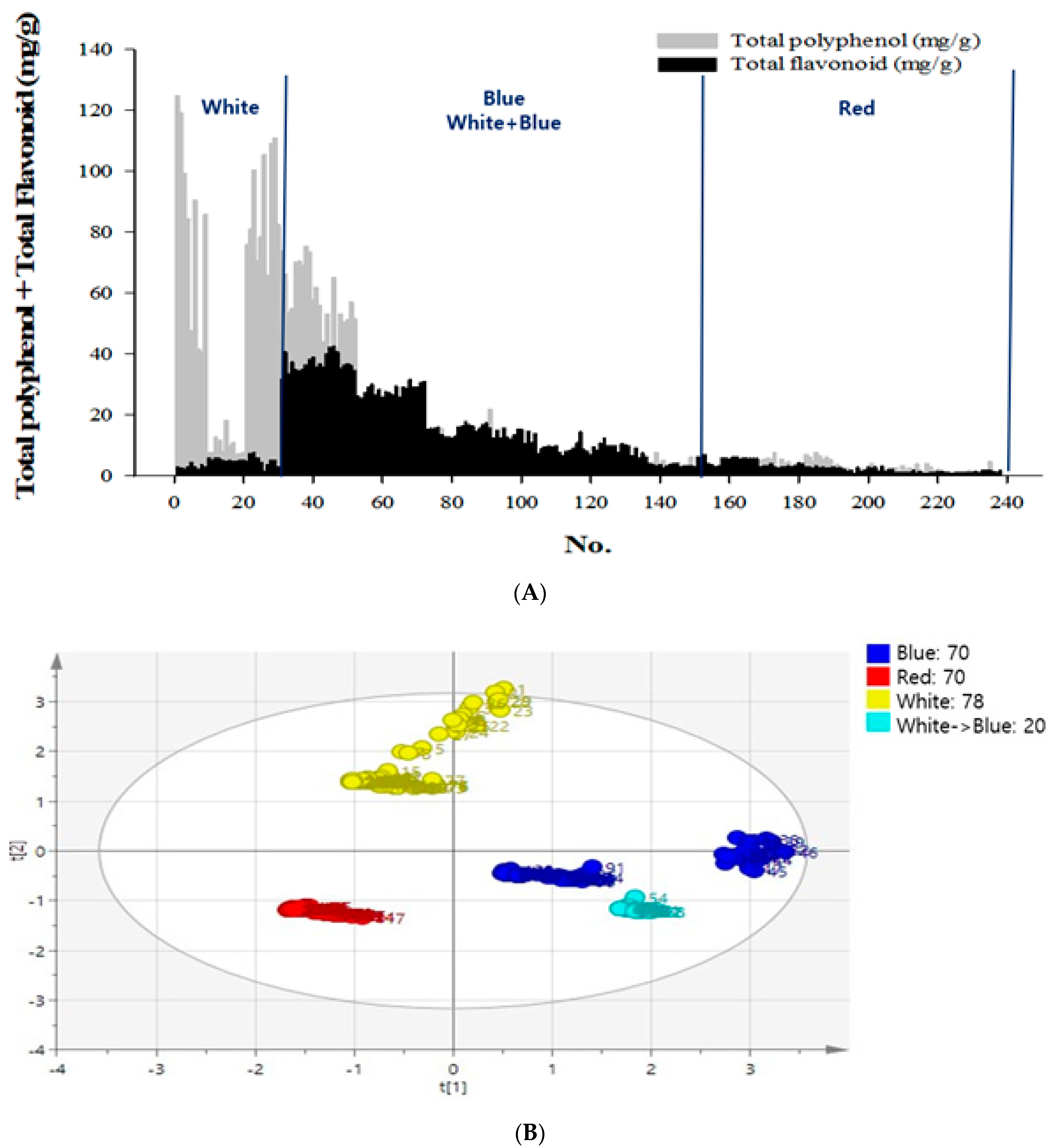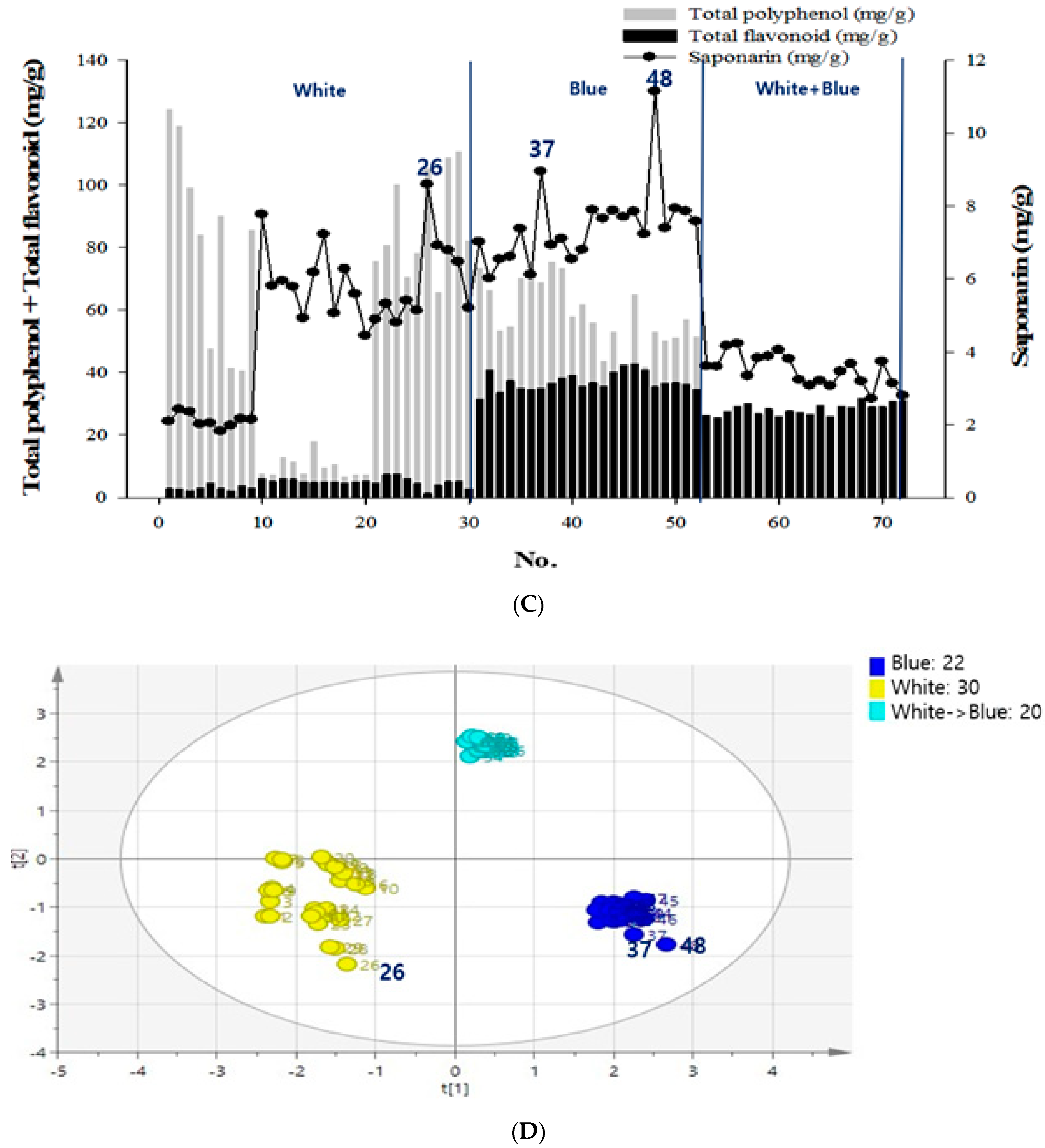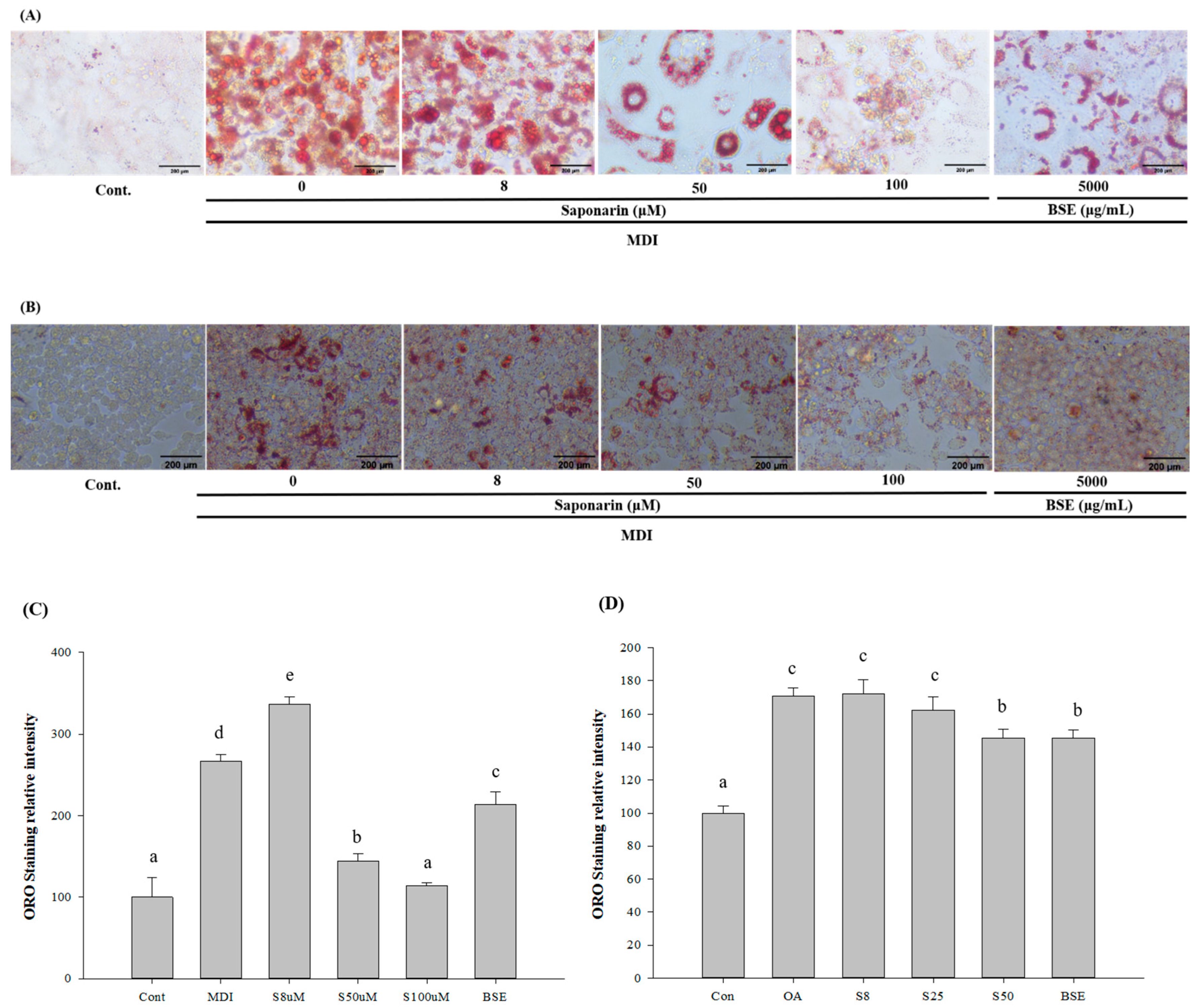Comparative Study of the Effects of Light Controlled Germination Conditions on Saponarin Content in Barley Sprouts and Lipid Accumulation Suppression in HepG2 Hepatocyte and 3T3-L1 Adipocyte Cells Using Barley Sprout Extracts
Abstract
1. Introduction
2. Results
2.1. Total Flavonoid and Polyphenol Content and PCA Analysis
2.2. Saponarin Content and PCA Analysis
2.3. Effect of BSE on Fat Contents in 3T3-L1 and HepG2 Cell Lines
3. Discussion
4. Materials and Methods
4.1. Materials
4.2. Cultivation of Barley Sprout
4.3. Total Polyphenol and Flavonoid Content
4.4. Quantification of Saponarin Using High-Performance Liquid Chromatography (HPLC)
4.5. Preparation of Barley Sprout Extracts
4.6. Cell Culture
4.7. Oil Red O Staining
4.8. Statistical Analysis
Author Contributions
Funding
Conflicts of Interest
References
- Lee, J.-J.; Lee, Y.-M.; Shin, H.-D.; Jeong, Y.-S.; Lee, M.-Y. Effects of vegetable sprout power mixture on lipid metabolism in rats fed high fat diet. J. Korean Soc. Food Sci. Nutr. 2007, 36, 965–974. [Google Scholar] [CrossRef]
- Byun, A.R.; Chun, H.; Lee, J.; Lee, S.W.; Lee, H.S.; Shim, K.W. Effects of a Dietary Supplement with Barley Sprout Extract on Blood Cholesterol Metabolism. Evid Based Complement. Altern. Med. 2015, 2015, 473056. [Google Scholar] [CrossRef] [PubMed]
- Eun, C.-S.; Hwang, E.-Y.; Lee, S.-O.; Yang, S.-A.; Yu, M.-H. Anti-oxidant and Anti-inflammatory Activities of Barley Sprout Extract. J. Life Sci. 2016, 26, 537–544. [Google Scholar] [CrossRef]
- Guan, Q.; Ding, X.-W.; Jiang, R.; Ouyang, P.-L.; Gui, J.; Feng, L.; Yang, L.; Song, L.-H. Effects of hydrogen-rich water on the nutrient composition and antioxidative characteristics of sprouted black barley. Food Chem. 2019, 299, 125095. [Google Scholar] [CrossRef]
- Idehen, E.; Tang, Y.; Sang, S. Bioactive phytochemicals in barley. J. Food Drug Anal. 2017, 25, 148–161. [Google Scholar] [CrossRef] [PubMed]
- Yoo, J.H.; Seong, E.S.; Lee, J.G.; Kim, C.J.; Choi, J.H.; Lee, G.H.; Hwang, I.S.; Hwang, E.B.; Lim, J.D.; Ahn, Y.S.; et al. Comparison of the Characteristics of Seed Germination and the First Stage of Growth in Cynanchum wilfordii (Maxim.) by Different Light Conditions. Korean J. Med. Crop. Sci. 2013, 21, 329–333. [Google Scholar] [CrossRef][Green Version]
- Byun, E.-H.; Kim, K.; Kim, Y.-E.; Cho, E.-J.; Min, H.-S.; Lee, J.-H.; Cho, G.-S.; Yoon, W.J.; Kim, B.C.; Ahn, D.-H.; et al. Comparison Study of Antioxidant Activity and Neuroprotective Effects of Barley Sprout Leaf, Root, and Stem Ethanol Extracts. J. Korean Soc. Food Sci. Nutr. 2018, 47, 973–980. [Google Scholar] [CrossRef]
- Lee, M.; Kim, D.; Park, S.-J.; Lee, D.; Choi, D.; Choi, B.-K.; Kim, K.M.; Lee, J. Effect of Barley Sprout (Hordeum vulgare L.) Water Extracts on Blood Flow Improvement In Vitro. J. Korean Soc. Food Sci. Nutr. 2018, 47, 77–82. [Google Scholar] [CrossRef]
- Lee, J.H.; Lee, S.Y.; Kim, B.; Seo, W.D.; Jia, Y.; Wu, C.; Jun, H.-j.; Lee, S.-J. Barley sprout extract containing policosanols and polyphenols regulate AMPK, SREBP2 and ACAT2 activity and cholesterol and glucose metabolism in vitro and in vivo. Food Res. Int. 2015, 72, 174–183. [Google Scholar] [CrossRef]
- Saunders, J.A.; McClure, J.W. The occurrence and photoregulation of flavonoids in barley plastids. Phytochemistry 1976, 15, 805–807. [Google Scholar] [CrossRef]
- McClure, J.W.; Wilson, K. Photocontrol of C-glycosylflavones in barley seedlings. Phytochemistry 1970, 9, 763–773. [Google Scholar] [CrossRef]
- Samuolienė, G.; Urbonavičiūtė, A.; Brazaitytė, A.; Šabajevienė, G.; Sakalauskaitė, J.; Duchovskis, P. The impact of LED illumination on antioxidant properties of sprouted seeds. Open Life Sci. 2011, 6, 68–74. [Google Scholar] [CrossRef]
- Lee, H.; Woo, S.-Y.; Ra, J.-E.; Lee, K.-S.; Seo, W.D.; Lee, J.H. Saponarin content and biosynthesis-related gene expression in young barley (Hordeum vulgare L.) seedlings. Plant Biotechnol. J. 2019, 46, 247–254. [Google Scholar] [CrossRef]
- Johkan, M.; Shoji, K.; Goto, F.; Hashida, S.; Yoshihara, T. Blue Light-emitting Diode Light Irradiation of Seedlings Improves Seedling Quality and Growth after Transplanting in Red Leaf Lettuce. Hortscience 2010, 45, 1809–1814. [Google Scholar] [CrossRef]
- Seo, K.H.; Park, M.J.; Ra, J.E.; Han, S.I.; Nam, M.H.; Kim, J.H.; Lee, J.H.; Seo, W.D. Saponarin from barley sprouts inhibits NF-kappaB and MAPK on LPS-induced RAW 264.7 cells. Food Funct. 2014, 5, 3005–3013. [Google Scholar] [CrossRef] [PubMed]
- Seo, W.D.; Yuk, H.J.; Curtis-Long, M.J.; Jang, K.C.; Lee, J.H.; Han, S.I.; Kang, H.W.; Nam, M.H.; Lee, S.J.; Lee, J.H.; et al. Effect of the growth stage and cultivar on policosanol profiles of barley sprouts and their adenosine 5’-monophosphate-activated protein kinase activation. J. Agric. Food Chem. 2013, 61, 1117–1123. [Google Scholar] [CrossRef] [PubMed]
- Seo, W.D.; Lee, J.H.; Jia, Y.; Wu, C.; Lee, S.J. Saponarin activates AMPK in a calcium-dependent manner and suppresses gluconeogenesis and increases glucose uptake via phosphorylation of CRTC2 and HDAC5. Bioorg. Med. Chem. Lett. 2015, 25, 5237–5242. [Google Scholar] [CrossRef]
- Ferreres, F.; Krskova, Z.; Goncalves, R.F.; Valentao, P.; Pereira, J.A.; Dusek, J.; Martin, J.; Andrade, P.B. Free water-soluble phenolics profiling in barley (Hordeum vulgare L.). J. Agric. Food Chem. 2009, 57, 2405–2409. [Google Scholar] [CrossRef]
- Benedet, J.A.; Umeda, H.; Shibamoto, T. Antioxidant activity of flavonoids isolated from young green barley leaves toward biological lipid samples. J. Agric. Food Chem. 2007, 55, 5499–5504. [Google Scholar] [CrossRef]
- Kang, B.M.; Sim, M.O.; Kim, M.S.; Yoo, S.J.; Yeo, J.H.; Jung, W.S. Anti-obesity effects of barley sprout young leaf on 3T3-L1 cells and high-fat diet-induced obese mice. Korean J. Med. Crop Sci. 2017, 25, 367–374. [Google Scholar]
- Kim, E.-J.; Choi, J.-Y.; Yu, M.-R.; Kim, M.-Y.; Lee, S.-H.; Lee, B.-H. Total polyphenols, total flavonoid contents, and antioxidant activity of Korean natural and medicinal plants. Korean J. Food Sci. Technol. 2012, 44, 337–342. [Google Scholar] [CrossRef]
- Lim, S.-H.; Kim, J.-K.; Kim, D.-H.; Sohn, S.-H.; Lee, J.-Y.; Kim, Y.-M.; Ha, S.-H. Flower color modification by manipulating flavonoid biosynthetic pathway. Hortic. Sci. Technol. 2011, 29, 511–522. [Google Scholar]
- Khalifa, R.; Shaaban, S.; Rawia, A. Effect of foliar application of zinc sulfate and boric acid on growth, yield and chemical constituents of iris plants. Ozean J. Appl. Sci. 2011, 4, 129–144. [Google Scholar]
- Hosseini, S.M.; Maftoun, M.; Karimian, N.; Ronaghi, A.; Emam, Y. Effect of zinc x boron interaction on plant growth and tissue nutrient concentration of corn. J. Plant Nutr. 2007, 30, 773–781. [Google Scholar] [CrossRef]
- Sinha, P.; Jain, R.; Chatterjee, C. Interactive effect of boron and zinc on growth and metabolism of mustard. Commun. Soil. Sci. Plant Anal. 2000, 31, 41–49. [Google Scholar] [CrossRef]
- Çavuşoğlu, K.; Kaya, F.; Kılıç, S. Effects of boric acid pretreatment on the seed germination, seedling growth and leaf anatomy of barley under saline conditions. J. Food Agric. Environ. 2013, 11, 376–380. [Google Scholar]
- Gubler, F.; Hughes, T.; Waterhouse, P.; Jacobsen, J. Regulation of dormancy in barley by blue light and after-ripening: Effects on abscisic acid and gibberellin metabolism. Plant Physiol. 2008, 147, 886–896. [Google Scholar] [CrossRef]
- Kim, E.J.; Lee, D.H.; Kim, H.J.; Lee, S.J.; Ban, J.O.; Cho, M.C.; Jeong, H.S.; Yang, Y.; Hong, J.T.; Yoon, D.Y. Thiacremonone, a sulfur compound isolated from garlic, attenuates lipid accumulation partially mediated via AMPK activation in 3T3-L1 adipocytes. J. Nutr. Biochem. 2012, 23, 1552–1558. [Google Scholar] [CrossRef]
- Sung, Y.Y.; Kim, D.S.; Kim, H.K. Akebia quinata extract exerts anti-obesity and hypolipidemic effects in high-fat diet-fed mice and 3T3-L1 adipocytes. J. Ethnopharmacol. 2015, 168, 17–24. [Google Scholar] [CrossRef]
- Cui, W.; Chen, S.L.; Hu, K.Q. Quantification and mechanisms of oleic acid-induced steatosis in HepG2 cells. Am. J. Transl. Res. 2010, 2, 95–104. [Google Scholar]
- Lee, M.-A.; Park, J.-K.; Um, M.-H.; Jeon, J.-W.; Lee, J.-M.; Park, Y.-K. Lipolytic Effect of Sparassis crispa Extracts in Differentiated 3T3-L1 Cells and High Fat Diet-induced Obese Mice. J. Korean Soc. Food Sci. Nutr. 2012, 41, 1708–1715. [Google Scholar] [CrossRef]
- Kim, J.H.; Kang, S.I.; Shin, H.S.; Yoon, S.A.; Kang, S.W.; Ko, H.C.; Kim, S.J. Sasa quelpaertensis and p-Coumaric Acid Attenuate Oleic Acid-Induced Lipid Accumulation in HepG2 Cells. Biosci. Biotechnol. Biochem. 2013, 77, 1595–1598. [Google Scholar] [CrossRef] [PubMed]
- Hwang, J.-T.; Nam, T.G.; Chung, M.-Y.; Park, J.H.; Choi, H.-K. Effect of Tartary Buckwheat Sprout on Non-Alcoholic Fatty Liver Disease through Anti-Histone Acetyltransferase Activity. J. Korean Soc. Food Sci. Nutr. 2017, 46, 169–176. [Google Scholar] [CrossRef]
- Cha, S.-Y.; Jang, J.-Y.; Lee, Y.-H.; Lee, G.-O.; Lee, H.-J.; Hwang, K.-T.; Kim, Y.-J.; Jun, W.-J.; Lee, J.-M. Lipolytic effect of methanol extracts from Luffa cylindrica in mature 3T3-L1 adipocytes. J. Korean Soc. Food Sci. Nutr. 2010, 39, 813–819. [Google Scholar] [CrossRef]
- Yoon, H.-j.; Lee, Y.-h.; Cha, B.-S. Causal Relationship of Non-alcoholic Fatty Liver Disease with Obesity and Insulin Resistance. J. Korean Diabetes 2014, 15, 76. [Google Scholar] [CrossRef][Green Version]
- Kim, Y. Inhibitory Effects of (-)-Epigallocatechin-3-gallate on Adipogenesis via AMPK Activation in 3T3-L1 Cells. Korean J. Food Nutr. 2017, 30, 1035–1041. [Google Scholar] [CrossRef]
- Winder, W.W.; Hardie, D.G. AMP-activated protein kinase, a metabolic master switch: Possible roles in Type 2 diabetes. Am. J. Physiol. Endocrinol. Metabol. 1999, 277, E1–E10. [Google Scholar] [CrossRef]
- Yu, Y.M.; Wu, C.H.; Tseng, Y.H.; Tsai, C.M.E.; Chang, W.C. Antioxidative and hypolipidemic effects of barley leaf essence in a rabbit model of atherosclerosis. Jpn. J. Pharmacol. 2002, 89, 142–148. [Google Scholar] [CrossRef]
- Obanda, M.; Owuor, P.O.; Taylor, S.J. Flavanol composition and caffeine content of green leaf as quality potential indicators of Kenyan black teas. J. Sci. Food Agric. 1997, 74, 209–215. [Google Scholar] [CrossRef]
- Zhishen, J.; Mengcheng, T.; Jianming, W. Research on antioxidant activity of flavonoids from natural materials. Food Chem. 1999, 64, 555–559. [Google Scholar] [CrossRef]





| Light | Water | Temperature | Hour | Nutrition | Concentration |
|---|---|---|---|---|---|
| Blue | Hydrogen Water | Control | - | - | - |
| 4 °C | 10 min | - | - | ||
| 60 min | |||||
| 25 °C | 10 min | ||||
| 60 min | |||||
| 40 °C | 10 min | ||||
| 60 min | |||||
| 60 °C | 10 min | ||||
| 60 min | |||||
| - | - | Zn | 0.1 | ||
| 0.01 | |||||
| 0.001 | |||||
| 0.0001 | |||||
| 0.00001 | |||||
| Bo | 0.1 | ||||
| 0.01 | |||||
| 0.001 | |||||
| 0.0001 | |||||
| 0.00001 | |||||
| Tab water | 4 °C | 10 min | - | - | |
| 60 min | |||||
| 25 °C | 10 min | ||||
| 60 min | |||||
| 40 °C | 10 min | ||||
| 60 min | |||||
| 60 °C | 10 min | ||||
| 60 min | |||||
| Blue + White | Hydrogen Water | Control | - | - | - |
| - | - | Zn | 0.001 | ||
| Bo | 0.001 | ||||
| 0.0001 | |||||
| White | Hydrogen Water | Control | - | - | - |
| - | - | Zn | 0.1 | ||
| 0.01 | |||||
| 0.001 | |||||
| 0.0001 | |||||
| 0.00001 | |||||
| Bo | 0.1 | ||||
| 0.01 | |||||
| 0.001 | |||||
| 0.0001 | |||||
| 0.00001 | |||||
| Se | 0.1 | ||||
| 0.01 | |||||
| 0.001 | |||||
| 0.0001 | |||||
| 0.00001 | |||||
| Si | 0.1 | ||||
| 0.01 | |||||
| 0.001 | |||||
| 0.0001 | |||||
| 0.00001 | |||||
| Tab water | Control | - | - | - | |
| 4 °C | 10 min | - | - | ||
| 60 min | |||||
| 25 °C | 10 min | ||||
| 60 min | |||||
| 40 °C | 10 min | ||||
| 60 min | |||||
| 60 °C | 10 min | ||||
| 60 min | |||||
| Red | Hydrogen Water | 4 °C | 10 min | - | - |
| 60 min | |||||
| 25 °C | 10 min | ||||
| 60 min | |||||
| 40 °C | 10 min | ||||
| 60 min | |||||
| 60 °C | 10 min | ||||
| 60 min | |||||
| Tab water | 4 °C | 10 min | |||
| 60 min | |||||
| 25 °C | 10 min | ||||
| 60 min | |||||
| 40 °C | 10 min | ||||
| 60 min | |||||
| 60 °C | 10 min | ||||
| 60 min |
Sample Availability: Samples of the compounds are not available from the authors. |
Publisher’s Note: MDPI stays neutral with regard to jurisdictional claims in published maps and institutional affiliations. |
© 2020 by the authors. Licensee MDPI, Basel, Switzerland. This article is an open access article distributed under the terms and conditions of the Creative Commons Attribution (CC BY) license (http://creativecommons.org/licenses/by/4.0/).
Share and Cite
Kim, J.S.; Jeong, E.; Jo, S.M.; Park, J.; Kim, J.Y. Comparative Study of the Effects of Light Controlled Germination Conditions on Saponarin Content in Barley Sprouts and Lipid Accumulation Suppression in HepG2 Hepatocyte and 3T3-L1 Adipocyte Cells Using Barley Sprout Extracts. Molecules 2020, 25, 5349. https://doi.org/10.3390/molecules25225349
Kim JS, Jeong E, Jo SM, Park J, Kim JY. Comparative Study of the Effects of Light Controlled Germination Conditions on Saponarin Content in Barley Sprouts and Lipid Accumulation Suppression in HepG2 Hepatocyte and 3T3-L1 Adipocyte Cells Using Barley Sprout Extracts. Molecules. 2020; 25(22):5349. https://doi.org/10.3390/molecules25225349
Chicago/Turabian StyleKim, Jae Sil, Eunseon Jeong, So Min Jo, Joonho Park, and Ji Yeon Kim. 2020. "Comparative Study of the Effects of Light Controlled Germination Conditions on Saponarin Content in Barley Sprouts and Lipid Accumulation Suppression in HepG2 Hepatocyte and 3T3-L1 Adipocyte Cells Using Barley Sprout Extracts" Molecules 25, no. 22: 5349. https://doi.org/10.3390/molecules25225349
APA StyleKim, J. S., Jeong, E., Jo, S. M., Park, J., & Kim, J. Y. (2020). Comparative Study of the Effects of Light Controlled Germination Conditions on Saponarin Content in Barley Sprouts and Lipid Accumulation Suppression in HepG2 Hepatocyte and 3T3-L1 Adipocyte Cells Using Barley Sprout Extracts. Molecules, 25(22), 5349. https://doi.org/10.3390/molecules25225349






